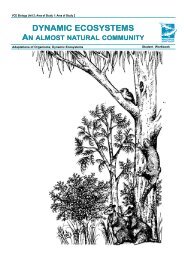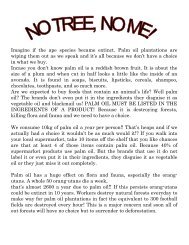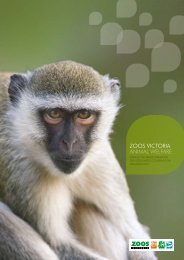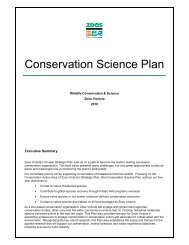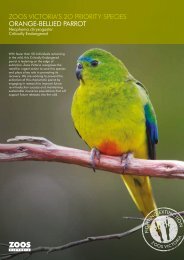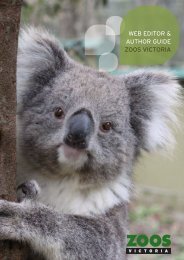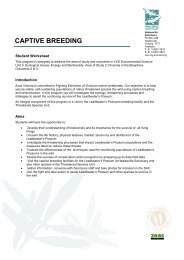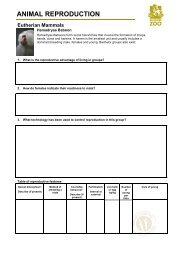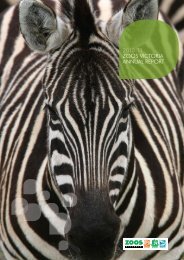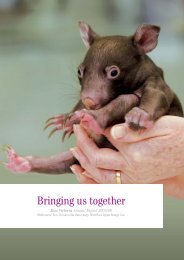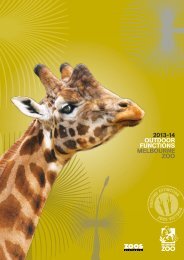WORZ VCE Reproduction ST 2013.pdf - Zoos Victoria
WORZ VCE Reproduction ST 2013.pdf - Zoos Victoria
WORZ VCE Reproduction ST 2013.pdf - Zoos Victoria
Create successful ePaper yourself
Turn your PDF publications into a flip-book with our unique Google optimized e-Paper software.
REPRODUCTION <strong>ST</strong>UDENT TRAIL<br />
Feed ‘em, breed ‘em and release ‘em<br />
<strong>VCE</strong> Biology Unit 2: Organisms and their environment<br />
Area of Study 1: Adaptations of organisms<br />
Introduction:<br />
This program addresses the key knowledge and skills related to <strong>VCE</strong> Biology Unit 2. It is<br />
designed to meet the requirements of the School Assessed Coursework (SAC) component<br />
for Outcome 1.<br />
This program aims to:<br />
• Determine the purpose of Zoo <strong>Victoria</strong>’s captive breeding program to ensure the<br />
survival of threatened species<br />
• Observe and interpret various animals reproductive adaptations, development and life<br />
cycles<br />
Education officer session<br />
The call of the last Christmas Island Pipistrelle bat inspired <strong>Zoos</strong> <strong>Victoria</strong> to develop the<br />
fighting extinction pledge. <strong>Zoos</strong> <strong>Victoria</strong> invests millions of dollars into staffing, resources and<br />
research for local and international conservation programs. We are committed to the<br />
recovery of 20 priority native threatened species such as Alpine She-oak Skink, Baw Baw<br />
Frog, Eastern Barred Bandicoot and Helmeted Honeyeater.<br />
1. Why does the zoo bother to conserve these threatened species?<br />
2a. <strong>Zoos</strong> <strong>Victoria</strong> has captive breeding programs for a number of threatened species. State<br />
the purpose of conducting captive breeding programs.<br />
2b. List some of the challenges the zoo faces with breeding animals in captivity.<br />
Eastern Barred Bandicoot (Perameles gunnii)<br />
Eastern Barred Bandicoots (EBBs) have one of the shortest gestation periods of any<br />
mammal, at just 12-13 days. Females give birth to 2-4 young who remain in the pouch for<br />
approximately 60 days. At just 75 days old the young are independent, and at 90 days they<br />
are sexually mature and can begin breeding. Their life span is 2-3 years in the wild.<br />
3. Describe how the EBBs short life cycle makes them a good recovery species to be bred in<br />
captivity.
In 1991, 40 EBBs were collected from the wild in Hamilton to form the basis of the captive<br />
breeding population. Subsequent analysis suggested that only 19 of these individuals bred<br />
successfully, thus becoming the founders for the entire wild and captive populations that now<br />
exist.<br />
4. Explain why 19 founders may cause issues for entire EBB population.<br />
Eastern Barred Bandicoots have developed various adaptations to help them survive in<br />
grassland and woodland environments; unfortunately one of them isn’t prey recognition!<br />
5. Observe an EBB and provide examples of a structural, physiological and behavioural<br />
adaptations for reproduction.<br />
Structural adaptation Physiological adaptation Behavioural adaptation<br />
Animal curators have many issues they need to address when breeding animals in captivity.<br />
The animal curator at Werribee Open Range Zoo needs to calculate how many EBBs can be<br />
moved into the 3.7 hectare Australian Journey exhibit?<br />
6. What limiting factors would determine the carrying capacity of the EBBs in the Australian<br />
Journey exhibit?
Vervet Monkeys live in small troops, usually consisting of about 20 members. Males and<br />
females form separate social hierarchies. The troop at Werribee Open Range Zoo has<br />
adapted to change throughout its life. During this change, the keepers have undertaken scan<br />
observations to determine the troop’s behavioural adaptations for reproduction and used<br />
these observations to form management plans for the troop.<br />
7. In pairs, use the scan observation method and Vervet Monkey Behaviour Key to record an<br />
individual monkey’s behaviour.<br />
Vervet Behaviour Key<br />
Activity<br />
SA Sitting Alert<br />
R Resting<br />
F Feeding<br />
Fo Foraging<br />
W Walking<br />
Interactions<br />
P Playing G Grooming oneself<br />
BG Being Groomed GA Grooming another<br />
C Contact S Sexual<br />
Pa Parenting V Vocalisations<br />
A Aggression Sub Submission<br />
U Unseen O Other<br />
Individual being observed (circle): infant/young/adult male/female<br />
1. 2. 3. 4. 5.<br />
6. 7. 8. 9. 10.<br />
11. 12. 13. 14. 15.<br />
16. 17. 18. 19. 20.<br />
8. In terms of Vervet Monkey survival, suggest why it may be beneficial to have a hierarchy<br />
of males and females.<br />
9. What adaptations do the Vervet Monkeys have in terms of raising their young?<br />
10. Suggest the reproductive management strategies the Zoo could be using to control<br />
breeding within the troop.
Animals have various reproductive strategies that they have adapted to help them<br />
survive.<br />
11. Choose 5 animals during your time at the Zoo to observe and complete the table below.<br />
Animal<br />
Sexual dimorphism<br />
Describe if present<br />
Method of attracting<br />
a mate<br />
Courtship behaviour<br />
Describe if present<br />
Fertilization<br />
Internal or<br />
external<br />
Live<br />
birth or<br />
Egg<br />
laying<br />
Care for<br />
young<br />
Yes/ No<br />
Internal<br />
Live<br />
birth<br />
Yes<br />
External<br />
Egg<br />
laying<br />
No<br />
Internal<br />
Live<br />
birth<br />
Yes<br />
External<br />
Egg<br />
laying<br />
No<br />
Internal<br />
Live<br />
birth<br />
Yes<br />
External<br />
Egg<br />
laying<br />
No<br />
Internal<br />
Live<br />
birth<br />
Yes<br />
External<br />
Egg<br />
laying<br />
No<br />
Internal<br />
Live<br />
birth<br />
Yes<br />
External<br />
Egg<br />
laying<br />
No




